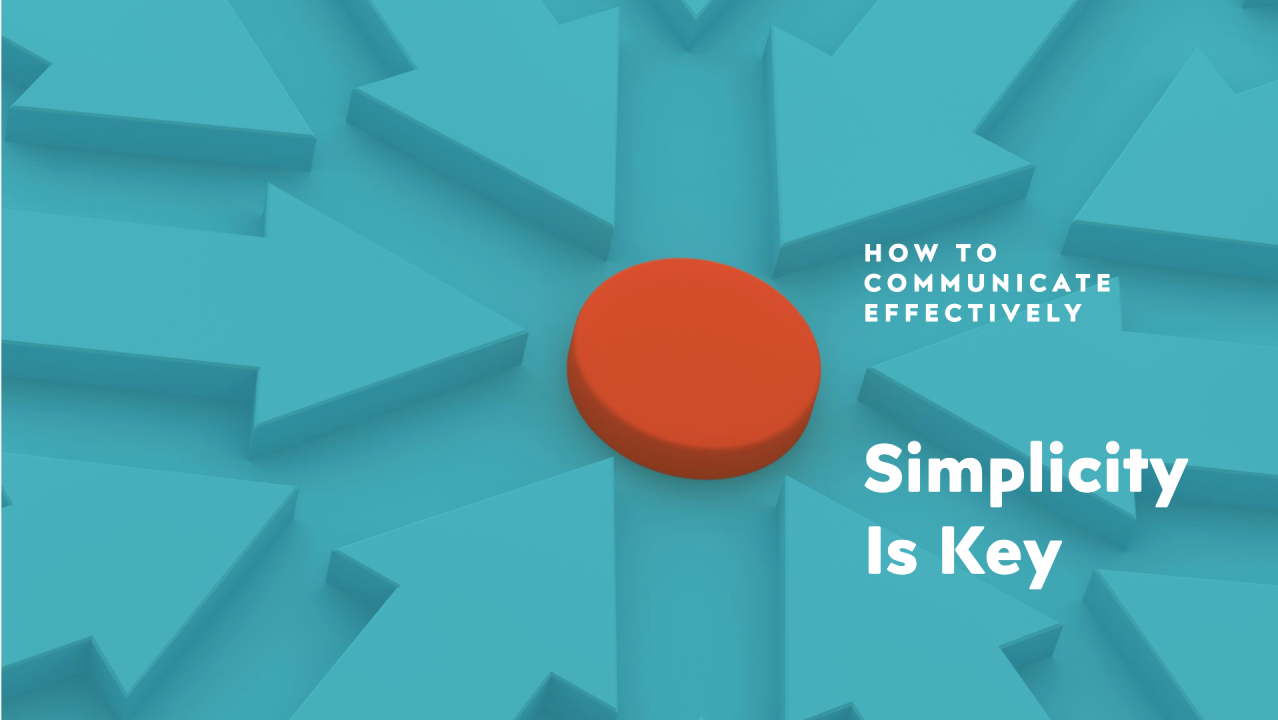How to Communicate Effectively by Keeping it Simple

Words cleverly strung together do not a message make. To cut through the background hum, messaging development as a communications tool —in all its forms—must reflect the passion you feel for your brand. And it must also speak to your audiences with value. The world is complex enough as it is. Why leave people asking “what does this all mean?”
Whether you’re delivering a speech, an elevator pitch, explaining a product functionality or crafting a corporate message, the power of simplicity is more compelling than you think. Simple, to-the-point messaging development that can be used as a communications tool is easier to understand. And will undoubtedly have a greater impact. Moreover, getting there is often harder than it seems.
Think about it this way. Which one would you gravitate more towards:
We unlock transformative productivity gains through our proprietary AI model, engineered to optimize high-performing teams and drive scalable, cutting-edge outcomes that ensure long-term business sustainability and competitive advantage.
OR
Our AI system automates mundane tasks that frees time for teams to focus on activities that matter. They work better, faster and achieve outcomes that give businesses staying power.
One can appear to know their stuff, however, when the deliverance is an esoteric explanation, people leave scratching their heads with absolutely no clue what you just said.
I wanted to share a few ways how you can create your messaging development with clarity through simplicity so it flows with understanding in all its forms. I mean let’s keep it real – deep down we all want to be memorable, and impactful. Indeed it’s easy to get caught up in the corporate speak or product functionalities. But it’s more compelling to talk in weekend speak. Credit goes to Sharon Gee of Feedonomics for that brilliant term.
Below are a few steps to hopefully get you started.
Start with a Clear Purpose
Before you speak or write, it’s essential to know exactly what you want to convey, but more importantly, what you want the audience to walk away with. Begin with a clear understanding of your core message and how you intend to use that message as a powerful communications tool. Ask yourself:
- What is the single most important point I want my audience to understand?
- What action or response do I want to prompt from them?
When you have a crystal-clear sense of your message’s purpose, and how you plan to use it as a communications tool, your messaging development should follow naturally. It’s easy to get sidetracked with extraneous details, but clarity arises from a sharp focus on the essentials.
Use Simple, Direct Language
K.I.S.S. We all remember this one right? This principle has no shelf life. Authentic, easily digestible and straightforward language should be the benchmark. Think of it as if you were having a conversation with a friend over dinner, at weekend brunch or in line for coffee. Avoid jargon, buzz words, outlandish claims or technical speak unless absolutely necessary. Instead of trying to impress with a wide vocabulary or convoluted sentence structures, aim for language that is accessible, relatable and universally understood.
For example, instead of saying:
“We should implement a synergistic approach to streamline our holistic customer engagement model.”
You could say:
“Let’s work together to improve how we connect with our customers.”
Simplicity doesn’t mean talking down to your audience. It means respecting their time and ensuring they don’t get bogged down by unnecessary complexity. A deer in the headlights is not a good look.
Prioritize Key Ideas
The human brain is wired to process only a limited amount of information at once. Don’t overwhelm your audience with too much at once. Stick to one central theme and support it with a few relevant points. Think of your message as a story: It should have a beginning, a middle and an end, with clear takeaways at the conclusion. You want to give that a-ha moment.
So for example, if you’re delivering a presentation, focus on three main points and organize your speech around them. Honestly, the same goes for video presentations as well. Trying to cover too many concepts will scatter your message and reduce its effectiveness.
Use Analogies and Metaphors
I love this one. Simplicity doesn’t mean reducing your message to dry, sterile facts. Think of this: To make abstract or complex ideas more relatable, consider using analogies or metaphors. They act as bridges between what people already understand and the new information you’re trying to convey.
For instance, if you’re explaining a complex concept like blockchain technology, you might say:
“Think of blockchain as a digital ledger where every transaction is recorded like a page in a book. Once a page is printed and written, it can’t be changed, leaving everything set and secure.”
This comparison makes a challenging idea more concrete and easier to grasp, without dumbing it down.
Be Concise, But Not Abrupt
Simplicity and brevity often go hand-in-hand, but there is a delicate balance. While you want to remove excess words, you don’t want to come off as curt or vague. The goal is to communicate your point as efficiently as possible, without sacrificing meaning.
One common mistake people make in the name of brevity is to under-explain. I recently had this experience with a former colleague during a coffee and catch up. This person was in the midst of building a consulting business and asked my feedback on some value propositions. The explanation used complex buzz words and was all over the place leaving me confused. You can imagine our chat ended up knee-deep in all things messaging development to make sure my friend doesn’t miss the mark.
So, instead of:
“The project timeline is subject to potential fluctuations in deliverables, which may be influenced by various unforeseen factors.”
Try:
“The project could have delays if unexpected issues arise.”
It’s shorter, but still to the point and relays the exact content that is impactful and more importantly, understood.
Engage the Audience with Stories
I come from a family of storytellers, with my dad being the best one. He was always animated and funny, really bringing us in every, single time he shared a story. Human beings are naturally drawn to stories. When we tell stories, we put them in a narrative context that people can follow. This is how I like to take my messaging development approach. A good story can break down complex concepts into digestible chunks, and connect emotionally with your message.
So for example, if you’re discussing a company’s mission or values, rather than listing abstract principles, share a real-life example of how those values were put into action. Or start out with an analogy or metaphor and go from there.
To me from a business perspective, Steve Jobs was one of the best storytellers out there. Think back when Steve introduced the first iPhone at Macworld in 2007. He used storytelling to create a memorable presentation. Steve didn’t just list its features—he told a story about how it combined three revolutionary devices: a phone, an iPod and an internet communicator, breaking the pattern of typical complexity and making it feel intuitive and exciting.
Some of you may have actually been there to feel that excitement and cheers of the crowd.
Be Mindful of Pace and Tone
In speaking, clarity comes not only from the words you choose but also from how you deliver them. Hence the term, communications tool. A slow, deliberate pace gives your audience time to absorb what you’re saying. Eye contact is prime too. Varying your tone of voice—emphasizing key words, modulating pitch and pausing for effect—can reinforce the simplicity of your message, and also draw your audience in closer to you.
When speaking, aim for a natural, conversational tone. Avoid speaking in a monotone or rushing through your message, as this can make even the simplest ideas seem muddled.
Furthermore, visuals such as infographics can complement (not complex) your message, as you speak.
Get Feedback, Adjust and Practice
Present your message a few times to select folks who you trust, or a few who would play into your target audience. Be open to constructive feedback. No sugarcoating. Put the defenses down.
Being receptive to honest, real feedback helps you gauge whether your message is understood and resonating. And it provides an opportunity to refine and simplify your communication further. And keep practicing. Yes ~ the saying “practice makes perfect” applies here! Once you get comfortable in your own skin, and confident in delivering your messages, you’ll find yourself in weekend speak before you know it.
In the End, Aim Not to Complicate
It’s no secret that attention spans are shorter and immediacy is the name of the game. In the end, aim to not complicate an already dense topic or subject. Remember, all your audience needs is simple speak. If conveying your message in this way isn’t your strong suit, then lean on a friend, colleague or hire someone. Play into your strength and theirs, so together you come out with a win/win. Create that space where your message can thrive.

